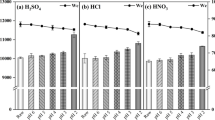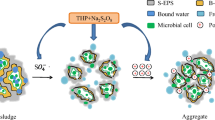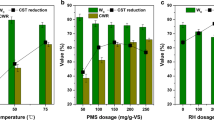Abstract
Activated persulfate oxidation has been proven to be an efficient advanced sludge treatment technique to improve sludge dewaterability. This study investigates the influence of persulfate on the transformation of phosphorus (P) and heavy metals (HMs) during the hydrothermal treatment of sewage sludge. The hydrothermal temperature, time, and persulfate concentration are optimized by a Box-Behnken design to obtain the best sludge dewaterability, which is expressed by capillary suction time (CST). The highest CST reduction efficiency is 90.5% at the optimal hydrothermal temperature, time, and concentration of persulfate, which are 145 °C, 2 h, and 150 mg/g dry sludge (DS), respectively. The distribution and transformation of P and HMs with different persulfate concentrations (100–200 mg/g DS) during the hydrothermal process are investigated. Results show that more than 90% of the P and HMs in the sludge are retained in sludge cakes after the hydrothermal treatment. The addition of SPS can make the P in the sludge cakes transform into more stable P species according to the extraction capacity of sequential extracts. It can be found from the ecological risk indexes of the HMs that the addition of SPS during the hydrothermal treatment of sludge can reduce the environmental risk of HMs. This study provides insights into the P and HM distribution and transformation during hydrothermal treatment with persulfate, providing a reference for sludge recovery strategies.




Similar content being viewed by others

Data Availability
All data generated or analyzed during this study are included in this published article (and its supplementary information files).
References
Appels L, Baeyens J, Degreve J, Dewil R (2008) Principles and potential of the anaerobic digestion of waste-activated sludge. Prog Energy Combust Sci 34:755–781
Chen H, Zhang C, Rao Y, Jing Y, Luo G, Zhang S (2017) Methane potentials of wastewater generated from hydrothermal liquefaction of rice straw: focusing on the wastewater characteristics and microbial community compositions. Biotechnol Biofuels 10:140
Chen LM, Liao YF, Ma XQ, Niu YD (2020) Effect of co-combusted sludge in waste incinerator on heavy metals chemical speciation and environmental risk of horizontal flue ash. Waste Manage 102:645–654
Cheng XM, Li T, Yang K, Liu F, Cheng XM (2014) Geochemical background and baseline value of chemical elements in urban coil in China. Earth Sci Front 21:265–306
Chen FF, Hu YY, Dou XM, Chen DZ, Dai XH (2015) Chemical forms of heavy metals in pyrolytic char of heavy metal-implanted sewage sludge and their impacts on leaching behaviors. J Anal Appl Pyrolysis 116:152–160
Dai L, Tan F, Wu B, He M, Wang W, Tang X, Hu Q, Zhang M (2015) Immobilization of phosphorus in cow manure during hydrothermal carbonization. J Environ Manag 157:49–53
Dewil R, Baeyens J, Appels L (2007) Enhancing the use of waste activated sludge as bio-fuel through selectively reducing its heavy metal content. J Hazard Mater 144:703–707
Funke A, Ziegler F (2010) Hydrothermal carbonization of biomass: a summary and discussion of chemical mechanisms for process engineering. Biofuels Bioprod Bior 4:160–177
Gao NB, Li ZY, Quan C, Miskolczi N, Egedy A (2019) A new method combining hydrothermal carbonization and mechanical compression in-situ for sewage sludge dewatering: bench-scale verification. J Anal Appl Pyrol 139:187–195
Hedley MJ, Stewart JWB, Chauhan BS (1982) Soil Sci Soc Am J 46:970
Huang HJ, Yuan XZ (2016a) The migration and transformation behaviors of heavy metals during the hydrothermal treatment of sewage sludge. 2016. Bioresour Technol 200:991–998
Hu YY, Yang F, Chen FF, Feng YH, Chen DZ, Dai XH (2018) Pyrolysis of the mixture of MSWI fly ash and sewage sludge for co-disposal: effect of ferrous/ferric sulfate additives. Waste Manage 75:340–351
Han XM, Wang F, Zhou BH, Chen HL, Yuan RF, Liu SH, Zhou XQ, Gao L, Lu Y, Zhang R (2019) Phosphorous complexation of sewage sludge during thermal hydrolysis with different reaction temperature and reaction time by K-edge XANES and 31P NMR. Sci Total Environ 688:1–9
Huang H, Yuan X, Zeng G, Zhu H, Li H, Liu Z, Jiang H, Leng L, Bi W (2011) Quantitative evaluation of heavy metals’ pollution hazards in liquefaction residues of sewage sludge. Bioresour Technol 102:10346–10351
Huang HJ, Yuan XZ (2016b) The migration and transformation behaviors of heavy metals during the hydrothermaltreatment of sewage sludge. Bioresour Technol 200:991–998
Huang RX, Fang C, Lu XW, Jiang RF, Tang YZ (2017) Transformation of phosphorus during (hydro)thermal treatments of solid biowastes: reaction mechanisms and implications for P reclamation and recycling. Environ Sci Technol 51:10284–10298
Huang R, Tang Y (2016) Evolution of phosphorus complexation and mineralogy during (hydro)thermal treatments of activated and anaerobically digested sludge: insights from sequential extraction and P K-edge XANES. Water Res 100:439–447
He YD, Zhai YB, Li CT, Yang F, Chen L, Fan XP, Peng WF, Fu ZM (2010) The fate of Cu, Zn, Pb and Cd during the pyrolysis of sewage sludge at different temperatures. Environ Technol 31:567–574
Kazi TG, Jamali MK, Kazi GH, Arain MB, Afridi HI, Siddiqui A (2005) Evaluating the mobility of toxic metals in untreated industrial wastewater sludge using a BCR sequential extraction procedure and a leaching test. Anal Bioanal J Chem 383:297–304
Kordkandi SA, Forouzesh M (2014) Application of full factorial design for methylene blue dye removal using heat-activated persulfate oxidation. J Taiwan Inst Chem Eng 45:2597–2604
Kepp U, Machenbach I, Weisz N, Solheim OE (2000) Enhanced stabilisation of sewage sludge through thermal hydrolysis – three years of experience with full scale plant. Water Sci Technol 42:89–96
Liu Q, Fang Z, Liu Y, Liu YY, Xu YF, Ruan XX, Zhang XL, Cao WM (2019) Phosphorus speciation and bioavailability of sewage sludge derived biochar amended with CaO. Waste Manage 87:71–79
Leng L, Yuan X, Huang H, Chen X, Zeng G (2014) The migration and transformation behavior of heavy metals during the liquefaction process of sewage sludge. Bioresour Technol 167:144–150
Liu TT, Liu ZG, Zheng QF, Lang QQ, Xia Y, Peng NN, Gai C (2018) Effect of hydrothermal carbonization on migration and environmental risk of heavy metals in sewage sludge during pyrolysis. Bioresour Technol 247:282–290
Li H, Wang Y, Zheng H (2018) Variations of moisture and organics in activated sludge during Fe0/S2O82− conditioning-horizontal electro-dewatering process. Water Res 129:83–93
Mahmoud A, Hoadley AFA, Citeau M, Sorbet JM, Olivier G, Vaxelaire J, Olivier J (2018) A comparative study of electro-dewatering processing performance for activated and digested wastewater sludge. Water Res 129:66–82
Neyens E, Baeyens J, Dewil R, De heyder, B., (2004) Advanced sludge treatment affects extracellular polymeric substances to improve activated sludge dewatering. J Hazard Mater 106:83–92
Olivier J, Conrardy J-B, Mahmoud A, Vaxelaire J (2015) Electro-dewatering of wastewater sludge: an investigation of the relationship between filtrate flow rate and electric current. Water Res 82:66–77
Park KY, Lee K, Kim D (2018) Characterized hydrochar of algal biomass for producing for solid fuel through hydrothermal carbonization. Bioresour Technol 258:119–124
Rauret G, Lópezsánchez JF, Sahuquillo A, Rubio R, Davidson C, Ure A, Quevauviller P (1999) Improvement of the BCR three step sequential extraction procedure prior to the certification of new sediment and soil reference materials. J Environ Monit 1:57–61
Shi WS, Liu CG, Shu YJ, Feng CP, Lei ZF, Zhang ZY (2013) Synergistic effect of rice husk addition on hydrothermal treatment of sewage sludge: fate and environmental risk of heavy metals. Bioresour Technol 149:496–502
Świerczek L, Cieślik BM, Konieczka P (2018) The potential of raw sewage sludge in construction industry: a review. J Clean Prod 200:342–356
Saveyn H, Pauwels G, Timmerman R, Van der Meeren P (2005) Effect of poly-electrolyte conditioning on the enhanced dewatering of activated sludge by application of an electric field during the expression phase. Water Res 39:3012–3020
Sun SC, Huang XF, Lin JH, Ma R, Fang L, Zhang PX, Qu JL, Zhang XH, Liu YL (2018) Study on the effects of catalysts on the immobilization efficiency and mechanism of heavy metals during the microwave pyrolysis of sludge. Waste Manage 77:131–139
Shao JG, Yuan XZ, Leng LJ, Huang HJ, Jiang LB, Wang H, Chen XH, Zeng GM (2015) The comparison of the migration and transformation behavior of heavy metals during pyrolysis and liquefaction of municipal sewage sludge, paper mill sludge, and slaughterhouse sludge. Bioresour Technol 198:16–22
Xiong Q, Zhou M, Liu MJ, Jiang SJ, Hou HB (2018) The transformation behaviors of heavy metals and dewaterability of sewage sludge during the dual conditioning with Fe2+-sodium persulfate oxidation and rice husk. Chemosphere 208:93–100
Xu YF, Yang F, Zhang L, Wang X, Sun Y, Liu Q, Qian GR (2018a) Migration and transformation of phosphorus in municipal sludge by the hydrothermal treatment and its directional adjustment. Waste Manage 81:196–201
Xu Q, Wang Q, Zhang W, Yang P, Du Y, Wang D (2018b) Highly effective enhancement of waste activated sludge dewaterability by altering proteins properties using methanol solution coupled with inorganic coagulants. Water Res 138:181–191
Yu GB, Liu Y, Yu S, Wu SC, Leung AO, Luo XS, Xu B, Li HB, Wong MH (2011) Inconsistency and comprehensiveness of risk assessments for heavy metals in urban surface sediments. Chemosphere 85:1080–1087
Yu Y, Yang X, Lei ZF, Yu R, Shimizu K, Chen N, Feng CP, Zhang ZY (2019) Effects of three macroelement cations on P mobility and speciation in sewage sludge derived hydrochar by using hydrothermal treatment. Bioresour. Technol. Reports 7:100231
Yuan XZ, Huang HJ, Zeng GM, Li H, Wang JY, Zhou CF, Zhu HN, Pei XK, Liu ZF, Liu ZT (2011) Total concentrations and chemical speciation of heavy metals in liquefaction residues of sewage sludge. Bioresour Technol 102:4104–4110
Zhen G, Lu X, Zhao Y, Chai X, Niu D (2012a) Enhanced dewaterability of sewage sludge in the presence of Fe (II)-activated persulfate oxidation. Bioresour Technol 116:259–165
Zhang XZ, Huang YQ, Song YP, Zhan H, Yin XL, Wu CZ (2017) The transformation pathways of nitrogen in sewage sludge during hydrothermal treatment. Bioresour Technol 245:463–470
Zhen G, Lu X, Zhao Y, Chai X, Niu D (2012b) Enhanced dewaterability of sewage sludge in the presence of Fe(II)-activated persulfate oxidation. Bioresour Technol 116:259–265
Zhang GM, Yang J, Liu HZ, Zhang J (2009) Sludge ozonation: disintegration, supernatant changes and mechanisms. Bioresource Technol 100:1505–1509
Funding
This work was supported by the National Natural Science Foundation of China (51908233). National Natural Science Foundation of China,51908233,Qiao Xiong
Author information
Authors and Affiliations
Contributions
Qiao Xiong: Methodology, Software, Formal analysis, Investigation, Writing — original draft. Jing Xia: Investigation. Xiang Wu: Investigation. Xu Wu: Software, Validation. Haobo Hou: Supervision. Hang Lv: Writing — review and editing.
Corresponding author
Ethics declarations
Ethics approval and consent to participate
Not applicable.
Consent for publication
Not applicable.
Competing interests
The authors declare no competing interests.
Additional information
Responsible Editor: Ricardo A. Torres-Palma
Publisher's note
Springer Nature remains neutral with regard to jurisdictional claims in published maps and institutional affiliations.
Supplementary Information
Below is the link to the electronic supplementary material.
Rights and permissions
About this article
Cite this article
Xiong, Q., Xia, J., Wu, X. et al. Influence of persulfate on transformation of phosphorus and heavy metals for improving sewage sludge dewaterability by hydrothermal treatment. Environ Sci Pollut Res 29, 33252–33262 (2022). https://doi.org/10.1007/s11356-022-18624-1
Received:
Accepted:
Published:
Issue Date:
DOI: https://doi.org/10.1007/s11356-022-18624-1



